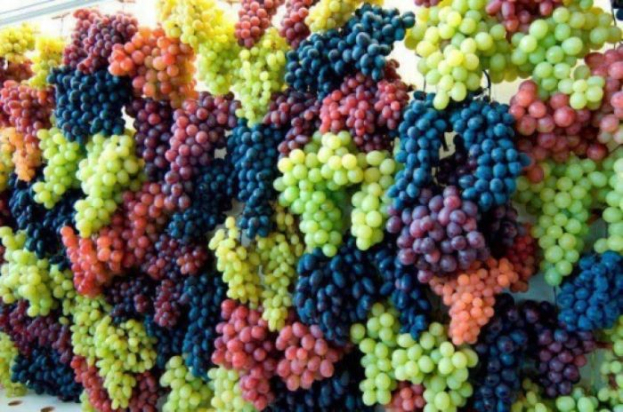Wine Enthusiast: 9 grapes to help you understand Armenian wine

The Wine Enthusiast dedicated an article to Armenian grape varieties that will help you understand Armenian wine. According to the author, to truly understand Armenian wine, it is worth starting with these local varieties.
White Grapes
Voskehat
Known as the queen of Armenian grape varieties, Voskehat has been cultivated for over 3,000 years, most commonly in the cooler, forested province of Aragatsotn and higher altitude sites in Vayots Dzor.
Voskehat is known for its longevity and ability to withstand increasingly unpredictable climates, thanks to its thick skin and hardy vines. (It’s not uncommon to find 150-year-old plantings of Voskehat.) Because of these traits, wineries are starting to look to this grape as the future of the region amidst warming conditions.
Voskehat is also malleable to style preferences. Depending on the growing season or winemaking treatment, the grape can be formed to bring out vegetal and key lime flavors or richer tropical notes of white flower and beeswax.
“I appreciate Voskehat because of its similarity to Chenin Blanc,” says Danya Degen, wine director at Meli in Washington, D.C. “Both grapes blend floral flavors with moderate acidity and fuller body. Like Chenin Blanc, acidity and body also make it a fabulous blending variety for sparkling wine. Armenia makes some of the best non-Champagne, non-Prosecco bubbles from Voskehat.”
Khatoun
Scott Stroemer, beverage director of Galit in Chicago, describes Khatoun (also known as Khatun, Khatouni or Khatun Kharji) as “a total acid freak.” With a yellow-green hue and near-colorless juice, Khatoun is known for its tart lemon, alpine flower and pineapple characteristics. “It’s great as a blending grape for Voskehat, which can be a bit flabby on its own,” he says.
Kangun
Kangun (or Gangun, depending on who you ask) was born during Soviet rule and specifically created for brandy production. It’s the child of three grape varieties: First, it was crossed with the Ukrainian grape Sukholimansky Bely and the Georgian grape Rkatsiteli, then that offspring was later crossed with Chardonnay. It settled well in Armenian terroir and was adopted for not just brandy, but white and sparkling wines. Expect a light straw color, ample freshness and notes of honey, wildflower and quince.
Garan Dmak
The white grape variety—found most commonly in the Ararat region—is planted widely in the clay and higher desert soils of Armenia. It’s known for its vegetal and ripe pear characteristics, though Stroemer compares it to something more French in nature. “I want this to be the Sancerre of 2024,” he says.
Red Grapes
Areni Noir
“Areni Noir, often known as Sev Areni or Sev Malahi, is considered the pearl of Armenian grape varieties,” says Bertil Jean-Chronberg, the owner and operator of Bonde Fine Wine Shop in Cambridge, Massachusetts. “It grows in the Vayots Dzor region—distinguished by a unique climate of mild winters and sunny days—at an average altitude of 3,000 to 5,900 feet. This terroir reflects the peculiar characteristics of this grape variety: In its youth, it produces wines with a pronounced acidity and a deep and intense color with delicate aromas of cherry, blackcurrant and black pepper. Aged in Armenian oak barrels, it becomes finer and more velvety and gains aromatic complexity and roundness.”
Areni Noir is “thin-skinned with bright acid,” adds Stroemer. “When grown in Vayots Dzor, Areni Noir becomes more Burgundian in presence with a black pepper finish.”
Tigrani
While Tigrani is Armenian in origin, part of its parentage comes from Georgia, the Caucasus’s other historic wine region. The grape is a cross between Saperavi, one of Georgia’s ancient grapes, and Areni Noir.
It’s seldom seen on its own. Instead, Tigrani lends fruit and florality to more tannic red varieties. The grapes are juicy, sweet and tart with deep natural color, a subtle spice and touches of ripe pomegranate.
Haghtanak
Translating to “victory” in Armenian, Haghtanak’s deep purple berries and intense red juice have made the grape one of Armenia’s most beloved varieties. It’s often found in blends—the deep color adds oomph to lighter grapes like Tozot—though if you do find a single varietal wine, it’s deeply cherry-like, hyper tannic with additional notes of plum, cloves, coffee and vanilla. “I find it quite similar to Saperavi from Georgia,” says Stroemer. “It’s red-fleshed and super tannic.”
Kakhet
Kakhet has deep roots that date back to the 4th century, but for the last few centuries, the grape has been exclusively reserved for Port-style sweet wines. Producers are wising up to the grape’s potential: While Haghtanak and Areni are rich and tannic, Kakhet tends to be berry-forward and terroir-driven—it’s light and aromatic, with notes of blackberry, black currant, fig and black pepper. Experts at U.C. Davis reckon the grape is a relative of the French varietal Carbonneau.
Tozot
“I see a lot of potential in this grape,” says Pavel Vardanyan, who makes a Tozot at Noa Wine in Vayots Dzor, located at the tippy-top of one of the region’s rolling mountains. “You can make Tozot elegant and ageable, you can make it into a rosé, you can make it into a blanc de noir,” he explains.
While Tozot isn’t found widely (and often only in older vineyards), the red grape offers up high acidity and freshness, with vibrant, bright strawberry notes not dissimilar to something from, say, Beaujolais.
Because of its rarity, “these days, it’s often blended into a still wine, used in table wine, dessert wine or distilled into Armenian brandy,” says Jean-Chronberg. “If vinified alone, it produces wines of great freshness, which are unique and invigorating.”
Follow NEWS.am STYLE on Facebook, Twitter and Instagram
- Sylvester Stallone's watches, including ‘Holy Grail’ of his collection, to be auctioned And on June 5, the Hollywood star is putting up 11 watches from his personal collection for auction at Sotheby's in New York...
- New York's Times Square tops list of world’s worst tourist traps By the end of 2024, 64.5 million tourists are expected to visit New York City—just a couple of million short of the record 66.6 million in 2019, with almost all of them guaranteed to at least stroll through Times Square. And according to a new poll, they'll hate it...
- Eurovision 2024: Alexander Rybak says Armenian song Jako is one of his favorites The winner of Eurovision 2009, Alexander Rybak, who won the Contest representing Norway with the song "Fairytale", says Armenian song Jako is one of his favorites among this year's songs...
- Eurovision 2024: How to vote for Armenia? Armenia's representatives in Eurovision 2024, the members of Ladaniva, will perform their song "Jako" in the second semi-final of the Contest, which will take place on May 9...
- ‘Wednesday’ 2nd season shooting kicks off Filming has begun for the second season of Wednesday. When the series first debuted on Netflix, it broke records. With 252 million views, it quickly became the most popular English-language series and spent 20 weeks in the global top ten...
-
21:11, May 8
World’s ex-richest man, Warren Buffett: Success isn't about money, it's about being loved by those you want to love -
20:26, May 8
Sylvester Stallone's watches, including ‘Holy Grail’ of his collection, to be auctioned -
19:27, May 8
New York's Times Square tops list of world’s worst tourist traps -
16:32, May 8
Horror movie to be made about Jesus’ childhood -
15:11, May 8
Khloe Kardashian speaks about problems she faced after birth of her son, Tatum -
15:00, May 8
Eurovision 2024: Alexander Rybak says Armenian song Jako is one of his favorites -
14:18, May 8
Anna Wintour bans 3 foods from Met Gala -
13:21, May 8
Eurovision 2024: How to vote for Armenia? -
13:17, May 8
‘Wednesday’ 2nd season shooting kicks off -
12:34, May 8
Jessica Biel takes bath with 9kg of salt before Met Gala -
11:23, May 8
Kim Kardashian reveals secrets behind her sensational Met Gala look -
10:46, May 8
Shakira wears bold satin white dress to Met Gala after-party
All materials
- Archive























